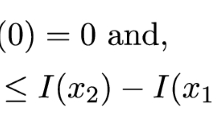Abstract
The main purpose of this paper is to show that left-monotone risk aversion, a meaningful refinement of strong risk aversion, characterizes decision makers for whom deductible insurance is optimal. A second goal is to prove that the deductible’s computation is particularly tractable in the case of Yaari’s decision makers.

Similar content being viewed by others
Change history
17 March 2022
A Correction to this paper has been published: https://doi.org/10.1007/s11238-022-09888-7
Notes
Note that \(h(1_{-})=f^{'}_-(1)\) left derivative of f is necessarily finite or infinite since h(p) is strictly increasing.
References
Arrow, K. J. (1965). Aspects of the theory of risk-bearing. Yrjö Jahnssonin Säätiö.
Chateauneuf, A., Cohen, M., & Meilijson, I. (1997). New tools to better model behavior under risk and uncertainty: An overview. Finance: Revue de l’Association Française de Finance, 18(1), 25–46.
Chateauneuf, A., Cohen, M., & Meilijson, I. (2004). Four notions of mean-preserving increase in risk, risk attitudes and applications to the rank-dependent expected utility model. Journal of Mathematical Economics, 40(5), 547–571.
Doherty, N. A., & Eeckhoudt, L. (1995). Optimal insurance without expected utility: The dual theory and the linearity of insurance contracts. Journal of Risk and Uncertainty, 10(2), 157–179.
Gollier, C., & Schlesinger, H. (1996). Arrow’s theorem on the optimality of deductibles: A stochastic dominance approach. Economic Theory, 7(2), 359–363.
Jewitt, I. (1989). Choosing between risky prospects: The characterization of comparative statics results, and location independent risk. Management Science, 35(1), 60–70.
Quiggin, J. (1982). A theory of anticipated utility. Journal of Economic Behavior & Organization, 3(4), 323–343.
Vergnaud, J.-C. (1997). Analysis of risk in a non-expected utility framework and application to the optimality of the deductible. Revue Finance, 18(1), 155–167.
Wakker, P. P. (2010). Prospect theory: For risk and ambiguity. Cambridge: Cambridge University Press.
Yaari, M. E. (1987). The dual theory of choice under risk. Econometrica: Journal of the Econometric Society, 95–115.
Acknowledgements
The valuable suggestions of the editors, of two anonymous referees, and of Brigitte Gosse are gratefully acknowledged. Mina Mostoufi appreciates the opportunity that Allianz Benelux Data Office provided to dedicate time to R&D activities during the work hours. The authors take the opportunity of this special issue to express their warm gratitude to Peter Wakker.
Author information
Authors and Affiliations
Corresponding author
Additional information
Publisher's Note
Springer Nature remains neutral with regard to jurisdictional claims in published maps and institutional affiliations.
The original online version of this article was revised: In Subsection 3.1, the sentence “Next, we discuss the left-monotone risk aversion in the Yaari’s framework” became obsolete after revision, so it has been removed.
Rights and permissions
About this article
Cite this article
Chateauneuf, A., Cohen, M. & Mostoufi, M. Optimality of deductible: a characterization, with application to Yaari’s dual theory. Theory Decis 92, 569–580 (2022). https://doi.org/10.1007/s11238-022-09880-1
Accepted:
Published:
Issue Date:
DOI: https://doi.org/10.1007/s11238-022-09880-1



